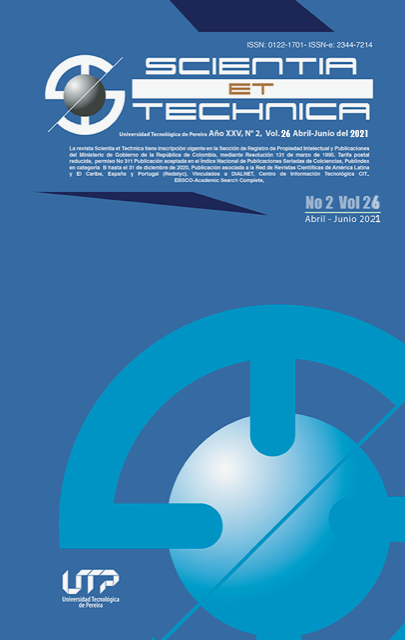Construction of a prototype Geiger Müller counter as dosimetric support in ionizing radiation monitoring
DOI:
https://doi.org/10.22517/23447214.24569Keywords:
Dosimetry, Geiger Müller Counters, Ionizing Radiation, Radiological Protection.Abstract
In radiological protection, it is important to measure the entry dose to the skin as a direct dosimetric indicator or as a base data for a subsequent calculation of the effective dose or equivalent dose. Geiger Counters are particle and ionizing radiation detectors that emit different radiation sources. They are used as environmental dosimeters, measuring the equivalent dose rate in air at key points in exposed and unexposed areas in radiology services. This article shows the construction of a Geiger Müller counter from the use of open source technologies such as the Arduino, these systems allow the integration of different applications at very affordable costs, easy programming and assembly, the device not only allows measurement radiation dose perceived in conventional radiology areas, but also has a thermo-hygrometer capturing two extra fundamental variables for monitoring temperature and relative humidity of the equipment operating environment, in its configuration the prototype performs measurements remotely and in real time, without exposing the professional who performs the monitoring; With the location of the device in the right place, said measurement is transmitted to be viewed from any computer or mobile device, also through sending to viewing platforms, having the freedom to carry out continuous monitoring, storing said information to keep track strict in the management of emissions in the rooms where the different radiological equipment operates.
Downloads
References
I. Castro-volio, “Indicadores citogenéticos para la identificación de exposición a radiación ionizante en humanos,” Acta Med. Costarric., vol. 55, no. 3, pp. 110–117, 2013, Accessed: Sep. 02, 2019. [Online]. Available: https://www.scielo.sa.cr/scielo.php?script=sci_arttext&pid=S0001-60022013000300002.
L. R. Arias, J. Uribe, and C. Resumen, “El Contador Geiger como Herramienta en la Enseñanza del Concepto de Radiación,” vol. 2, pp. 1–3, 2007.
M. Crispín et al., “Quantification of the absorbed doses by means of dosimetry thermoluminiscent in dental radiology,” Rev. Odontológica Mex., vol. 14, no. 4, pp. 231–236, 2010, Accessed: Sep. 02, 2019. [Online]. Available: https://www.medigraphic.com/cgi-bin/new/resumenI.cgi?IDARTICULO=25289.
SIEVERT, “Institut de Radioprotection et de Surete Nucleaire.” https://www.sievert-system.org/ (accessed Dec. 01, 2018).
M. Donya, M. Radford, A. Elguindy, D. Firmin, and H. Magdi, “Radiation in medicine : Origins, risks and aspirations,” Glob. Cardiol. Sci. Pract., vol. 2014, no. 4, p. 57, 2014.
P. de las N. U. para el M. Ambiente, Radiación efectos y fuentes. .
ICRP, “International Commission on Radiological Protection.” http://www.icrp.org/ (accessed Dec. 01, 2018).
ICRU, “International Commission on Radiation Units and Measurements (ICRU).” https://icru.org/ (accessed Dec. 01, 2018).
UNSCEAR, “United Nations Scientific Committee on the Effects of Atomic Radiation.” http://www.unscear.org/ (accessed Dec. 01, 2018).
IAEA, “Organismo Internacional de Energía Atómica | Átomos para la paz y el desarrollo.” https://www.iaea.org/es (accessed Dec. 01, 2018).
D. Ginzburg, “Ionisation chamber for measurement of pulsed photon radiation fields,” Radiat. Prot. Dosimetry, vol. 174, no. 3, pp. 297–301, 2017, doi: 10.1093/rpd/ncw145.
O. García, A. I. Lamadrid, L. Morera, and T. Mandina, “Introducción y desarrollo de la dosimetría biológica en Cuba,” Panor. Nucl., vol. 37, pp. 49–53, 2005, [Online]. Available: http://files.sld.cu/chernobil/files/2009/05/introduccion-y-desarrollo-en-la-dosimetria-biologica-en-cuba.pdf.
J. Azpeitia Armán and J. P. Domingo, Manual para técnico superior en imagen para el diagnóstico y medicina nuclear. Madrid: Editorial Médica Panamericana, 2016.
G. Peretti, E. Romero, M. ; Cejas, and C. Marqués, “Diseño De Un Contador Geiger Con Capacidad De Autoverificación Integrada,” [Online]. Available: http://www.iberchip.net/VII/cdnav/pdfp/p7.pdf.
S. Korff, “How the Geiger Counter started to crackle : Electrical counting methods in early radioactivity research,” Ann. Phys., vol. 525, no. 6, pp. 88–92, 2013, doi: 10.1002/andp.201300726.
C. Pham, “Communication performances of IEEE 802.15.4 wireless sensor motes for data-intensive applications: A comparison of WaspMote, Arduino MEGA, TelosB, MicaZ and iMote2 for image surveillance,” J. Netw. Comput. Appl., vol. 46, pp. 48–59, 2014, doi: 10.1016/j.jnca.2014.08.002.
Downloads
-
Vistas(Views): 1244
- PDF (Español (España)) Descargas(Downloads): 1020
Published
How to Cite
Issue
Section
License
Copyrights
The journal is free open access. The papers are published under the Creative Commons Attribution / Attribution-NonCommercial-NoDerivatives 4.0 International - CC BY-NC-ND 4.0 license. For this reason, the author or authors of a manuscript accepted for publication will yield all the economic rights to the Universidad Tecnológica of Pereira free of charge, taking into account the following:
In the event that the submitted manuscript is accepted for publication, the authors must grant permission to the journal, in unlimited time, to reproduce, to edit, distribute, exhibit and publish anywhere, either by means printed, electronic, databases, repositories, optical discs, Internet or any other required medium. In all cases, the journal preserves the obligation to respect, the moral rights of the authors, contained in article 30 of Law 23 of 1982 of the Government Colombian.
The transferors using ASSIGNMENT OF PATRIMONIAL RIGHTS letter declare that all the material that is part of the article is entirely free of copyright. Therefore, the authors are responsible for any litigation or related claim to intellectual property rights. They exonerate of all responsibility to the Universidad Tecnológica of Pereira (publishing entity) and the Scientia et Technica journal. Likewise, the authors accept that the work presented will be distributed in free open access, safeguarding copyright under the Creative Commons Attribution / Recognition-NonCommercial-NoDerivatives 4.0 International - https://creativecommons.org/licenses/by-nc-nd/4.0/deed.es license.



